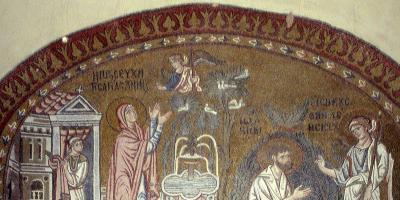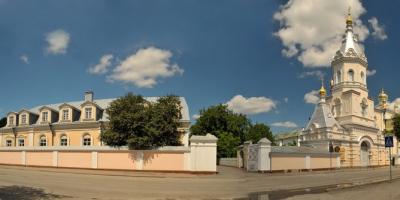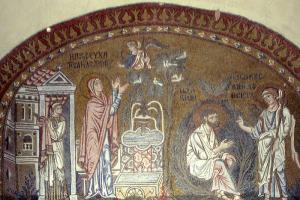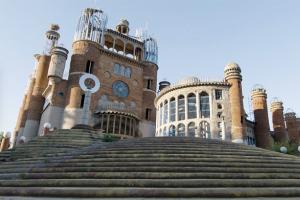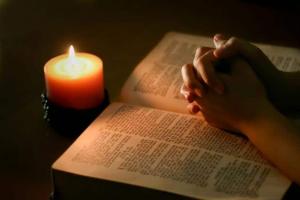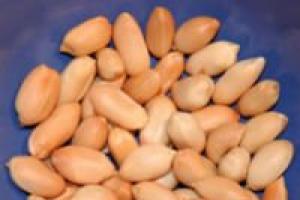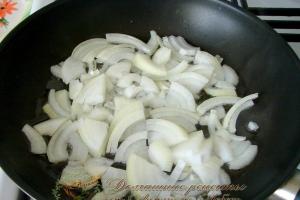Saint Joachim was the husband of Saint Anne, the father of the Mother of God. Hagiographic literature gives Joachim the following origin: “ His genealogy is as follows: David's son Nathan gave birth to a son, Levi, Levi gave birth to Melchia and Panfir, Panfir gave birth to Varpafir, and Varpafir gave birth to Joachim, the father of the Mother of God." Joachim lived in Nazareth. He married Anna, the youngest daughter of the priest Matthan from the high priestly family of Aaron. According to her father, she was from the tribe of Levi, and according to her mother, she was from the tribe of Judah. The conception and birth of the Mother of God is known from the apocryphal Proto-Gospel of James (2nd century). According to this apocrypha, Joachim and Anna did not have children for a long time. When the high priest denied Joachim the right to make a sacrifice to God, since he “did not create offspring for Israel,” he withdrew into the desert, and his wife remained at home alone. At this time, they both had a vision of an angel who announced: “ The Lord has heeded your prayer, you will conceive and give birth, and your offspring will be talked about all over the world.».
After this gospel, Joachim and Anna met at the Golden Gate of Jerusalem. And so Joachim approached with his flocks, and Anna, who was standing at the gate, saw Joachim coming, and, running up, hugged him, and said: “I know now that the Lord has blessed me: being a widow, I am no longer a widow, being barren, I Now I’ll conceive!” And Joachim found peace in his home that day. (Proto-Gospel of James (4:7-8)). After this, Joachim came to the Jerusalem temple, saying: “If the Lord has mercy on me, then the priest’s golden plate will show me.” And Joachim brought his gifts, and looked intently at the plate, approaching the altar of the Lord, and did not see sin in himself. (Proto-Gospel of James (5:1-2)). Anna conceived, “the months allotted to her passed, and Anna gave birth in the ninth month”. The date of conception, December 9, was set on the basis that it would be 9 months from the date of the Nativity of the Virgin Mary (September 8).
The four canonical Gospels do not mention the name of Mary's mother. Anna appears only in the apocryphal tradition, in particular in the Proto-Gospel of James, as well as in the Gospel of Pseudo-Matthew and the Golden Legend. The tradition was also influenced by the “Sermon on the Nativity of the Blessed Virgin Mary” by Andrew of Crete (VII-VIII centuries). According to Jewish custom, on the 15th day after the birth of the baby, she was given the name indicated by the angel of God - Mary. The parents, out of gratitude to the Lord, promised to send the child to the Temple. Mary was brought into the Temple at the age of three. Joachim and Anna placed their daughter on the first step, and, to everyone’s amazement, three-year-old Mary climbed to the very top without outside help, where the high priest Zechariah received her.
According to his life, Joachim lived 80 years. Saint Anna died at the age of 79, two years after him, having spent them at the temple next to her daughter. Memory of the Dormition of Righteous Anna on August 7 (July 25, Old Art.). Joachim and Anna were buried near the future tomb of their daughter, as well as the grave of Joseph the Betrothed, in the Garden of Gethsemane, under the Mount of Olives, near Jerusalem. These tombs were located on the edge of the Valley of Jehoshaphat, which lay between Jerusalem and the Mount of Olives.
————————
Library of Russian Faith
The life of the holy righteous Godfather Joachim and Anna. Great Menaion of Cheti →
Veneration of the holy righteous Godfather Joachim and Anna
The Orthodox Church calls Joachim and Anna Godfathers, since they were the ancestors of Jesus Christ according to the flesh.
Memorial Days:
- Dormition of St. Anna - August 7 (July 25, old style),
- memory of Godfather Joachim and Anna - September 22 (September 9, old style),
- Conception of the Blessed Virgin Mary by Saint Anna - December 22 (December 9, old style).
In 710, the relics and maforium of St. Anne were transferred from Jerusalem to Constantinople. The records of medieval Western pilgrims report the discovery of the shoulder and palm of St. Anne in the Cyprus monastery of Stavrovouni.
————————
Library of Russian Faith
→
Kontakion and Troparion to the Righteous Saints Joachim and Anna
Troparion, tone 1
Who was in the lawful canopy of the righteous, the God-given Child is purebred to us, Joachim and Anna. On the same day, the divine church brightly triumphs and joyfully celebrates your honorable memory, glorifying the Father, who raised the horn of salvation for us in the house of God.
Kontakion, tone 2
Now Anna is having fun, having resolved her misery. And he nourishes the Most Pure One, convening all, praising the One who bestowed, from her earthly lies, the one Mother, the inexperienced one.
Holy Righteous Joachim and Anna. Icons
In the iconographic tradition, there are both separate and joint images of the holy righteous Godfather Joachim and Anna. Icons where saints are depicted together are usually illustrations from their lives, showing some of the moments described in the apocrypha, for example, the meeting of the spouses after the joyful news of the conception of the Virgin Mary was announced to them. Joachim and Anna in the icon are in the center of the composition. Around there are scenes of previous and subsequent events: a meeting with an angel, the birth of Mary, her introduction into the temple, etc.







On separate icons, the righteous saints Joachim and Anna are depicted full-length or waist-length. Saint Joachim is depicted with curly black hair with large gray streaks and a small roundish beard, wearing a tunic and a robe with excrements, and the holy righteous Anna is thin, with an oblong face and a sharp nose with a small hump; her underwear is a tunic, over the tunic there is a split veil, and there is a veil on her head. The earliest depiction of Saint Anne is from 8th-century frescoes in the Church of Santa Maria Antiqua in Rome. A fresco from Farras (Egypt) dates back to the same century.












Temples in the name of the holy righteous Joachim and Anna
In the East, churches dedicated to the righteous saints Joachim and Anna appear from the 6th century, while in the West only in the 12th century. In the middle of the 6th century, a temple was built in Constantinople in the name of St. Anna. In the Middle Ages, in the cities of Apt (Provence) and Duren (Germany) they believed that they possessed the relics of Anna. In the West, increased veneration of Anna began in the 14th century. The first monastery in the name of the Holy Righteous Anne in the West arose in 701 in Floriac near Rouen.
In the village of Brezova, Raska district of Serbia, there is a church in the name of Saints Joachim and Anna, also known as the Royal Church, in honor of its founder King Milutin. It was erected in 1314, in the form of a compressed cross, with an exterior in the shape of an octagonal dome. Built from stone and tuff.

In Pskov, on Uspenskaya Street, there was the Yakimansky Convent (XIV century) and its main church in the name of the holy righteous Joachim and Anna (1544). The monastery was abolished in the 18th century, and the church became a parish. During Soviet times, the temple was closed. In 1947–1951 restoration took place here. The renewal of the church is now beginning.

Also in the name of the righteous saints Joachim and Anna, the chapel of the Church of the Nativity in Yaroslavl was consecrated. The Nativity Church in stone was built in 1635-1644 on the site of the wooden church of the same name.

Holy Righteous Joachim and Anna. Paintings
Many painters depicted the righteous saints Joachim and Anna on their canvases: Giotto di Bondone (1266-1337), Masolino da Panicale (c. 1383 - c. 1440), Masaccio (1401-1428), Albrecht Durer ( 1471-1528), Wolf Trout (1480-1520) and others.





Holy Righteous Joachim and Anna. People's memory
Holy Righteous Anna is depicted on the coat of arms of the cities of Kobrin (Belarus), St. Annen (Germany), Jachimov (Czech Republic), Gorodets (Belarus).

The names of one of the streets of Moscow - Bolshaya Yakimanka and the villages in the Shuisky district of the Ivanovo region - Yakimanna were formed from the combined pronunciation of the names of the righteous saints Joachim and Anna.
Church of Saints Joachim and Anna in Mozhaisk
In the old part of Mozhaisk, not far from the Mozhaisk Kremlin, there is a unique complex of temples. The majestic, large stone church of Mozhaisk, built in 1871 according to the design of Kazimir Vikentievich Grinevsky, with a bell tower built in 1893 according to the design of Pavel Georgievich Egorov, in the name of the saints and righteous Godfather Joachim and Anna, with the chapels of St. Sergius of Radonezh and the Akhtyrka Icon of the Mother of God ; and a small temple in the name of the holy martyr Leonty of Rostov, the southern wall of which, facing the 19th century temple, is made of blocks of white stone and betrays the great antiquity of the building.
The temple complex is located on the site of the ancient Joachimoan monastery, abolished in 1764. It is unknown when the Joachimoan Monastery was founded (the first information about it dates back to 1596–1598). Then there was one stone church of the Holy Father Joachim and Anna with two chapels - the Resurrection of Christ and Leontius, Bishop of Rostov the Wonderworker.
The terrible era of persecution of the Church of Christ during the Soviet period did not spare the churches of Mozhaisk. The small church of Leonty of Rostov houses an archive, but the large church of Joachim and Anna, one of the few on Russian land, did not stop serving God and people either during the Great Patriotic War or during Soviet times. But hard times also affected the Church of Joachim and Anna: the priests of the temple, Kirill Kharitonovich Chmel and Nikolai Aleksandrovich Safonov, were shot at the Butovo training ground in 1937, and in 1938 the priest of the temple, Arefa Akimovich Nasonov, was shot.
Currently, the Temple of Joachim and Anna, as before, occupies a worthy place in Mozhaisk, filling its life with transcendental content, again and again becoming a true decoration of the city. The shrine of the temple are two large ancient sculptural images of St. Nicholas of Mozhaisk “with sword and hail.”
The holy spring of Sergius of Radonezh is located near the temple.
Pilgrims from different parts of Russia flock to these holy places. The special atmosphere that reigns here attracts not only Orthodox Russians, but also believers from neighboring countries.
From the book The Secret of Fate An archaeological study of the book of the prophet Jeremiah author Oparin Alexey AnatolievichChapter 15 About King Joachim's attempt to stop time The news that Joachim had stopped paying him tribute certainly angered Nebuchadnezzar. But he knew how not to obey impulses, and to strike only when it was most profitable and safe. In 599 he begins
From the book Lives of the Saints - the month of September author Rostovsky DimitriThe Life of the Saints and the Righteous Father of God Joachim and Anna The holy righteous Joachim came from the tribe of Judah, from the house of King David. His genealogy is as follows: the son of David Nathan gave birth to a son Levi, Levi gave birth to Melchia and Panfir, Panfir gave birth to Barpafir, Barpafir gave birth to Joachim, the father
From the book Lives of the Saints - the month of October author Rostovsky Dimitri From the book Holidays of the Orthodox Church author Almazov Sergey Frantsevich From the book Saint Anna author Filimonova L.V.Church (Holy Trinity Church) of Joachim and Anna in Gus-Khrustalny In 1811, a retired cornet of the Life Guards Cavalry Regiment, Sergei Akimovich Maltsov, with the help of the capital of his mother, Maria Vasilievna, became the owner of the Gusev factory, which he acquired from his brother Ivan. He
From the book Saints of the South Slavs. Description of their life author (Gumilevsky) FilaretTemple of St. Anna Kashinskaya in St. Petersburg The Church in honor of the Holy Blessed Princess Anna Kashinskaya in St. Petersburg is the first church of St. Anna Kashinskaya, built and consecrated in honor of this saint. And today it remains the only temple in Russia, entirely
From the book Life of Elder Paisius the Holy Mountain author Isaac Hieromonk16 o'clock. Memory of the teacher. JOAKIM OSOGOVSKY. Saint Joachim1) was one of the four great Bulgarian hermits, who with their exploits aroused hundreds and thousands of Bulgarians to Christian asceticism. The first was St. John of Rila; the exploits of St. Joachim were performed in
From the book of Lives of the Saints (all months) author Rostovsky DimitriThe Dispassion of Saints Joachim and Anna While at Sinai, the Elder experienced a supernatural event in the Holy Spirit: he was given the opportunity to comprehend the chaste and sanctified relationship of the holy godfathers Joachim and Anna, from whom the Most Holy Theotokos was conceived and born. The old man was
From the book Fundamentals of the Art of Holiness, Volume 4 author Barnabas BishopThe Life of the Saints and the Righteous Father of God Joachim and Anna The holy righteous Joachim came from the tribe of Judah, from the house of King David. His genealogy is as follows: the son of David Nathan gave birth to a son Levi, Levi gave birth to Melchia and Panfir, Panfir gave birth to Barpafir, Barpafir gave birth to Joachim, the father
From the book St. Tikhon. Patriarch of Moscow and All Russia author Markova Anna A.Memory of the holy martyrs Alexander the bishop, Heraclius the warrior and four wives: Anna, Elizabeth, Theodotia and Glyceria Saint Alexander converted and baptized many into the faith of Christ. He was taken by the hegemon and, forced to sacrifice to idols, endured much torment, but did not
From the book Interpretation of the Gospel author Gladkov Boris Ilyich From the book Complete Yearly Circle of Brief Teachings. Volume IV (October–December) author Dyachenko Grigory Mikhailovich From the author's book From the author's bookCHAPTER 42. Jesus with the former high priest Annas. Jesus before the court of the Sanhedrin. Peter's denial. Secondary meeting of the Sanhedrin at dawn. Judas' repentance. Jesus with the former high priest Annas Having arrived in Jerusalem, the guards did not bring Jesus to the high priest Caiaphas,
From the author's bookLesson 2. Presentation of the Most Holy Theotokos into the temple (Lessons from the celebrated event: a) we should visit the temple of God more often; b) must firmly keep these vows, and c) parents must take their children to the temple from their early years) I. Parents of the Blessed Virgin Mary, Righteous Joachim
From the author's bookLesson 3. Introduction to the Temple of the Blessed Virgin Mary (What is needed for going to the temple of God to be beneficial?) I. The righteous parents of the Blessed Virgin Mary, Joachim and Anna, vowed to dedicate their child to God for service in the temple, if God grants him to them. The Lord gave them
Church of St. righteous Godfather Joachim and Anna on Yakimanka
B. Yakimanka st., 13 (wasteland)
"First mentioned in 1493. In the 16th century it gave its name to the street where it stood. Since 1625, the main altar of the Annunciation; in 1657 it was shown as a wooden one. The stone one was built in 1684. The warm refectory was 1701; November 29 in its the chapel of St. Sergius was given an antimension. In Catherine's time, a separate bell tower was built, a new altar was built. In 1866, a western portal was built. Inside, the furnishings are new: the main iconostasis is from 1848, the chapels are from 1866. From antiquity, the refectory has a floor made of squares of white stone. ".
“At the church there was a parish school and a parish guardianship in memory of the deliverance of their imperial majesties from danger during the crash of the royal train on October 17, 1888 near the station of Borki.”
The temple was closed after 1917. “By 1965, the bell tower was broken down to the 1st tier, the temple was beheaded. Inside there was a blacksmith shop for experimental workshops. The appearance of the building was dirty, grimy, factory superstructures were stuck to it” (M. L. Bogoyavlensky) . There were attempts to achieve its restoration - the artist Pavel Korin wrote the following in an article in the Komsomolskaya Pravda newspaper in 1966: “... I cannot come to terms with the fact that in the seven-tent (probably a typo - the temple was seven-headed. - P . P.) the temple of Joachim and Anna of the 17th century on Bolshaya Yakimanka is now a forge and press shop..."
All this, however, ended with the fact that on the night of November 3-4, 1969, when constructing a new passage from the street. Dimitrov on Bolshaya Polyanka the temple was blown up. As an article in the typewritten magazine "Veche" reported, the explosion was carried out according to the design of the head of the Mosproekt-13 workshop A. B. Gurkov with the blessing of the chief architect of Moscow M. V. Posokhin (the article was called "The Fate of the Russian Capital"; it seems to us that the names of the destroyers must not be forgotten - P.P.). The pretext for this latest demolition of a 17th-century church in Moscow was this: it allegedly interferes with a new passage; this turned out to be another lie, since now the site of the church is completely a roadway and an empty lawn.
“Once upon a time, B. Yakimanka Street directly went to the B. Kamenny Bridge through a small Gildyansky Bridge, thrown over a lake lying on its way. However, from the middle of the 17th century, traffic to the Kremlin moved to the neighboring Kosmodamiansky Bridge (later M. Kamenny), from which the current Polyanka began, and the old highway was built up. Therefore, those traveling from the center had to make a small detour along the Yakimanskaya embankment to enter Bolshaya Yakimanka from the M. Kamenny Bridge. This inconvenience persisted until 1969, when, in order to solve the transport problem through the old quarters a direct passage was made (! - P.P.) from Bolshaya Polyanka to Dimitrova Street, along which all the traffic went.”
On the empty lawn between two passages, where the Church of Joachim and Anna previously stood, which gave its name to the entire Yakimanskaya Street, now there is only a row of concrete “shoes” with poles on which periodically changing slogans are hung.
Icon of St. right Joachim and Anna from the church of the same name is now located in the nearest functioning Church of St. John the Warrior on Yakimanka.
Date of publication or update 05/06/2017
Temples of the Moscow region
Church of the Holy Righteous Joachim and Anna
G. Mozhaisk.Icon of saints and righteous Joachim and Anna. Fresco on the Church of St. and the righteous Joachim and Anna in Mozhaisk.
It is unknown when the Joachiman Monastery was founded; the first information about it is 1596-1598. Then there was one “church of the Holy Father Joachim and Anna made of stone and two chapels of the Resurrection of Christ, and Leontius Bishop of Rostov the Wonderworker”, on the monastery there was “a church with a meal of the Three Saints Basil the Great, Gregory the Theologian, John Chrysostom, wooden top”, Holy Gate , “yes, the monastery has two abbot’s cells with a canopy and closets, and six brethren’s cells,” at the monastery there was a settlement of 22 courtyards; in 1629, under it “the monastery site along one hundred and twenty fathoms, across seventy fathoms and even seventy fathoms”; he had up to 16 wastelands near Mozhaisk and 3 in Kolotsk camp and a mill.”
List from the scribe book of 1629: “The Yakimanskaya Monastery, and in it the Church of the Holy Fathers Akim and Anna is made of stone and there are two chapels: the Resurrection of Christ and Leonty, Bishop of Rostov the Wonderworker. And in the church there are images of God’s mercy: the image of the local Akim and Anna on the greenery. The royal doors and pillars and canopy are made of gold. Yes books: on the throne is the Gospel, yes the Complete Treod, yes the Trefolog, yes the Consumer, yes the Menaion of the Father, yes the Colored Treod, yes the Missal, all written. Robes and surplices of old linen. Yes, there are five bells on the bell tower. There was no sovereign tribute in money or bread.”
Of the abbots of the Yakiman monastery, the one mentioned at the beginning of the 16th century is known. Joachim, in January 1649, Feodosia. Builders - Simeon in 1648, Job in 1655, Abraham in 1667, Varlaam in 1673-1675.
In 1675, the monastery was transferred to the jurisdiction of the Luzhetsky Monastery, in 1764 it was separated and converted into a parish church, which still exists today. According to the inventory of 1763: “In that monastery there is one stone church of an ancient building in the name of Godfather Joachim and Anna, about one chapter, the head is covered with wooden scales, on the head there is an iron cross, about one throne.
Yes, attached to it is a stone church, which was in the name of Leonty, Metropolitan of Rostov, which was previously dilapidated, which is now a building under repair. Above this chapel at the top there is a wooden bell tower, covered with planks, the head is made of wooden scales, and an iron cross (this part of the temple has survived to this day).
And in that monastery there are no other stone and wooden churches, abbots’ and fraternal stone and wooden cells, shops, stone and wooden buildings and a stone fence.
Around that monastery, instead of a fence, there is a log fence in the pillars, and in the corners there are chimneys cut down instead of towers... And now there is no one in that monastery as an abbot, builder or monastics. And now it is obvious: the white priest Alexey Grigoriev, the sexton Alexander Akinfiev... Nothing happens to the priest and sexton in cash and grain salaries, but they are content with that monastery from the parish people, but they have a priest and a sexton, under the courtyards and gardens of the estate -one tithe of monastery land..."
In the 1770s. the temple was completely rebuilt, and in 1867, after the demolition of the ancient temple adjacent to it, it became independent. The southern white stone wall remains from the temple built in the 90s. XIV century, and he had a northern one. In the 1880s a refectory has been added. “On September 4, 1774, in the city of Mozhaisk, at the Church of the Godfather of Joachim and Anna, it was allowed to build a chapel again in the name of the unmercenaries Cosmas and Damian.
In 1776, there were 100 parish yards at the Joakiman Church, 7 dessiatines of estate and arable land. In 1779, there were priest Alexy Grigoriev, deacon Alexander Iakinfov, sexton Ivan Alekseev, sexton Ivan Alexandrov.
In 1777, the dean of the city churches was the priest of the Akhtyra Church, Pyotr Maksimov. “The chapel church was originally in the name of Cosmas and Damian, but when the priest Dionysius, after the invasion of the French, was transferred from the Akhtyrskaya church by the enemy to the burned church and, observing the temple icon, he renamed the church in the name of the Akhtyrskaya Mother of God. This icon was created by Voivode Stupishin.”
Initially, there were 46 parish houses attached to the Joachiman Church.
In 1813, the Akhtyrskaya and Ilyinskaya churches, burned by the French, and some villages from the Peter and Paul and Ilyinskaya churches were assigned to it, and from that time there were 169 houses in the parish, and in 1855 - 263 houses.
In 1855, a clergyman was assigned to the Elias Church, as a result of which 124 courtyards were separated from the Joakiman Church.
The ancient temple, which had fallen into disrepair, was dismantled in 1867. The part that had survived to this day was also to be dismantled by decision of the diocesan authorities, but in 1884, at the request of the Mozhai tradesman Mikhail Samorodov, it was decided to renew the temple at his expense.
By 1916, the temple was restored only from the outside, but the inside was not consecrated.
During Soviet times, it was not operational; an archive was placed in it. The clergy consisted of a priest, deacon, sexton and sexton. The clergy and clergy had their own houses and stood on church land.
In 1821, the priest of the Yakiman Church was John Isidorov, in 1829 he was the same.
In 1821, John Isidorovich Vesyoloye was ordained a priest at the Joachiman Church. He was the son of a priest. Graduated from the Moscow Seminary with a 1st category certificate.
In 1833 he was appointed to be present on the Mozhaisk Spiritual Board.
In 1836 he was confirmed by choice as a general confessor.
In 1837 he was appointed dean of the district churches. In the family of Fr. John and his wife Mavra Mikhailovna had 10 children: Alexander, Mikhail, George, Gregory, Pelageya, Agrippina, Ekaterina, Anna, Alexey, Alexandra.
In 1840, priest John Vesyoloye was still serving in the Joachiman Church. At the same time, Jacob Ivanovich Nebezranov served as a deacon at the Joachiman Church, and Vasily Mikhailovich Ozeretskovsky served as a sexton. A new three-altar church was founded in a new location (with the blessing of Philaret, Metropolitan of Moscow).
It stands next to an ancient temple. The large stone church of the Holy Righteous Joachim and Anna was built in 1871 according to the design of Kazimir Vikentyevich Grinevsky (1825-1885), with a bell tower built in 1893 according to the design of Pavel Georgievich Egorov, and chapels (1916) of St. Sergius of Radonezh and the Akhtyrka Icon of God Mother, later the chapels were consecrated in the name of St. Nicholas the Wonderworker and the Akhtyrka Icon of the Mother of God. The shrine of the temple are two large ancient sculptural images of St. Nicholas of Mozhaisk “with a sword and hail” (city).
In 1869, priest Evgeniy Aleksandrovich Lebedev served in the Joachiman Church. In 1877, Alexander Nikolaevich Anserov, priest of the Elias Church in Mozhaisk, was appointed instead of him, who had accepted the position of economist at the Moscow Theological Seminary.
In 1878, on October 8, the chapel of the Akhtyrskaya Mother of God was consecrated by Archimandrite Dionysius of the Mozhaisk Luzhetsky Monastery. On January 14, 1879, the chapel of St. Sergius of Radonezh was consecrated.
In 1882, the priest of the St. Nicholas Cathedral, Viktor Kirillovich Troitsky, replaced Anserov, who entered the Savvinsky Zvenigorod Monastery. The headman is the Mozhai merchant Gavriil Egorovich Malakhov. In the chronicle compiled by priest Evgeny Lebedev, a mistake was made: at the church there was not the Sretensky women's monastery, but the Joakimansky men's monastery. Under the priest Trinity, after a 22-year break, the construction of the stone bell tower was continued (1871). She was watched by a great artist, architect Pavel Georgievich Egorov. Completion cost 6,000 rubles: 3.5 thousand rubles. church money, 2.5 thousand rubles. - donations. The construction was completed in one summer.
In 1876 and 1884 sons Sergei and Nikolai were born into the family of the priest of the Joachiman Church, Victor Trinity; they graduated, respectively, from the Don (in 1893) and Zvenigorod (in 1898) Theological schools and in 1902 and 1904. Bethany Seminary.
In 1876, 1878 and 1880 sons Sergei, Nikolai and Ivan were born into the family of deacon of the Joachiman Church Peter Pavlovich Lebedev. They graduated from the Zvenigorod Theological School (in 1880, 1890 and 1892) and the Bethany Seminary (in 1895, 1896 and 1898).
The parish had a parochial and a city girls' parochial school, established in 1893 and 1862, respectively.
In 1916, the church warden was the Mozhaisk merchant of the 3rd guild, Gavriil Egorovich Malakhov (75 years old), who had been in office since 1886.
The staff of the clergy consisted of a priest, a deacon and two psalm-readers.
In 1914, priest Sergiy Viktorovich Troitsky (40 years old) was assigned to the temple. In 1902, he graduated from the Bethany Seminary with a 2nd category certificate and was appointed as a teacher at the Kukarinsky parochial school.
In 1905, he was appointed to the place of his father, Archpriest Viktor Kirillovich Troitsky, as a priest in the village of Ilyinskaya. Ilyinsky on Bodnya Church.
In 1912 he was awarded a legguard, in 1916 a skufya. U o. Sergius and his wife Maria Feodorovna had three children: Tatyana, Victor, Zinaida. In 1918, Father Sergius was summoned to a collection point for public works and never returned home. The relatives were so frightened that they did not even dare to find out what happened to him.
In 1916, the deacon at the Joakiman Church was Pyotr Pavlovich Lebedev (71 years old), and the psalm-readers were Sergei Vasilyevich Troitsky and Ivan Ivanovich Tsvetkov.
From 1931 to 1932, Hieromartyr Arefa (Nasonov) served in the Church of the Holy Righteous Joachim and Anna. He was born on October 24, 1888 in the village. Debtor of the Zhitomir district of the Volyn province in the family of peasants Joakim and Anna Nasonov. After graduating from the ministerial school and passing the exams necessary to take the position of a rural teacher, Arefa Akimovich began teaching in the village in 1913. Debtor. He married Agrippina Grigorievna Polyakova, who graduated from high school and worked as a teacher.
On August 1, 1914, Arefa Nasonov was ordained a priest at a church in the same village, but did not give up his teaching. The young priest distinguished himself by converting many schismatics to Orthodoxy, for which he was especially respected by Archbishop Anthony (Khrapovitsky), who ruled the Volyn diocese.
In 1916 Fr. Arefa moved to the village. Golyshevo, Rivne district, Volyn province, and in the same year was evacuated to the village. Andreevka, Chembarsky district, Penza province. There he served until 1931.
In 1931 he was arrested by the OGPU. After keeping the priest in custody for two weeks, the authorities released him without bringing any charges or interrogating him. After the revolution Fr. Arefa was deprived of voting rights, and his family was considered disenfranchised.
Since 1929, the priest was subject to an individual tax; in 1930, for non-payment of state obligations, the family’s cow was taken away.
In 1931 Fr. Arefa moved to Mozhaisk, where until 1932 he served in the Church of Saints Joachim and Anna. He, along with his wife and seven children, lived in a gatehouse at the church. The authorities attempted to close the temple by taking away the keys from the believers. But the attempt failed.
This temple is one of the few that was not closed during Soviet times.
September 3, 1932 Fr. Arefa was arrested and placed in the Butyrsky detention center on September 4, where he was kept throughout the investigation. He was accused of being a priest, “living in a 3-kilometer zone of a military warehouse... systematically treating citizens who attended church in an anti-Soviet spirit.” During the investigation, the priest confirmed that he belongs “to the Tikhonov movement.”
All the accusations brought against him about. Arefa denied it, saying that he did not plead guilty. Testimony against him, in addition to other false witnesses, was given by the priest Theodore of Kazan. Being questioned as a witness, he said that Fr. Arefa is a monarchist, condemns collective farm construction and cannot come to terms with the existence of Soviet power, expects its speedy death, and in general, “Nasonov is a dangerous element in the conditions of Mozhaisk reality.”
On September 11, 1932, the OGPU troika sentenced priest Arefa Nasonov to three years of exile in Kazakhstan. After 8 months, he escaped from exile and went to the Penza region, where he once lived for about 15 years. He hid there until 1936, but apparently he could no longer remain without service and asked the clergy to come to the parish.
In 1936, he was appointed to serve in the Church of the Holy Unmercenaries Cosmas and Damian in the village. Bychki Saraevsky district of the Ryazan region.
On December 31, 1937, the NKVD “troika” sentenced Fr. Arrested for execution. The priest was shot on January 10, 1938 and buried in an unknown mass grave.
In March 1933, the Moscow Regional Executive Committee decided to close the Akim and Anna Church in Mozhaisk. The resolution states that the building of the Joachiman Church must be used as an auditorium for the ShKM (collective farm youth school) and 1st level schools. Believers can use the Church of the Ascension. But the Lord saved the temple.
In 1937, at the Butovo training ground near Moscow, the priests of the church of Fr. Kirill Kharitonovich Chmel (b. 1879) and Fr. Nikolai Alexandrovich Safonov (b. 1900). Nikolai Safonov, rector of the Joakiman Church, was born in Saratov, had a lower spiritual education. In Mozhaisk he lived on the street. Krupskaya, 15. Arrested on December 5, 1937, sentenced on December 9 and executed on December 15. Priest Kirill Chmel was born in the Kharkov province, had a secondary spiritual education, lived in Mozhaisk, st. Kozhevennaya, 30. Arrested on November 14, 1937, sentenced on November 25 and executed on December 2.
The Joakiman temple was not destroyed; it was the only functioning temple in the entire city.
In 1941, during the retreat of the Red Army, they wanted to blow it up, but the believers did not allow it.
During the German occupation, Archpriest Alexander Voskresensky and Deacon Georgy Khokhlov served in the Joachiman Church, from whom a German soldier wanted to take off his fur coat in the courtyard of the pharmacy, but the deacon entered into a fight, and the fur coat remained on his shoulders, but another German soldier took off his warm mittens . In the Joachiman Church the nun Matryosha was the watchman. A group of drunken German soldiers was breaking into her, and then church elder Ilya Vasilyevich Tsvelev happened to be there. He began to admonish them. The Germans beat him severely. During the shelling, up to 1,000 people took refuge in the basement under the Joachiman Church.
In the mid-1950s. Priest Mikhail Nesterov (1919-1996) served in the Church of the Holy Righteous Joachim and Anna.
In 1946 he was ordained a deacon. He served in Mariupol, Orekhovo-Zuevsky district (Drezna, Kabanovo), was ordained a priest and appointed rector of the cathedral in Mozhaisk. Nobody went to the temple; it stood empty, with broken glass, and there was no choir. Father Mikhail slowly adjusted everything, served for 5 years and left the staff after two heart attacks.
Father Mikhail was born into a peasant family, he had 6 brothers and sisters. From childhood he was at the temple, despite the ridicule and humiliation to which he was subjected at school, and became a psalm-reader.
In May 1941 he was drafted into the army and sent to the North; he fought on the Rybachy Peninsula throughout the war. Came back with sore legs. He entered the Theological Institute at the Novodevichy Convent in Moscow. Got sick with a stomach ulcer. After serving in Mozhaisk and leaving the state, he went to Bolshevo, where his Aunt Maria served as a psalm-reader. He again began to serve in a church in the vicinity of Pushkino, again left the staff, but at the end of the same year he was appointed to the Antioch courtyard in Moscow, where he served from 1959 to 1977. They loved him there and nicknamed him “fluffy” for his lush hair. Father Mikhail was awarded Soviet military orders and medals and orders of the Church of Antioch. Due to illness, he retired and served on holidays in the Bolshevo Church of the Unmercenary Saints Cosmas and Damian. He was sick a lot, his leg was taken away, and he was brought to the temple in a wheelchair, and for the last six months he did not get out of bed.
From 1953 to 1958, Protodeacon Sergius Ivanovich Dobrov served in St. Nicholas Cathedral (died in 1971 at the age of 64).
Until 1953, he served at the Trinity Cathedral in Kalinin, and in 1950 he was elevated to the rank of protodeacon.
Since 1958 he served in the St. Nicholas Church of Edinoverie in Moscow.
In 1956-1957 served in the church in the name of the Holy Righteous Joachim and Anna in the city of Mozhaisk, mitred archpriest (since 1965) Ioann Nikolaevich Sokolov (d. 1969). He was born in 1887 in Vladimir.
In 1903 he graduated from a 4-year ministerial school there, and the following year he completed a one-year course for psalm-readers at the Vladimir bishop's house. Bishop Damian of Pereslavl in 1926 ordained him a presbyter for the church in the village. Daratnikovo, Vladimir diocese.
The rite of consecration of the foundation of the temple in 1999 and the rite of consecration in 2001 were performed by Archbishop Gregory of Mozhaisk.
On Yakimanskaya Street Mozhaisk, between and rises an equally interesting architectural monument - Church of Joachim and Anna, or, as the locals call it, the Yakiman Church.
In distant times on the spot Church of Joachim and Anna in Mozhaisk there was a monastery of the same name, about which we find information in the chronicles of the 16th century. And in the scribe book of 1629 you can read:
“The Yakimanskaya Monastery, and in it the Church of the Holy Fathers Akim and Anna is made of stone and there are two chapels: the Resurrection of Christ and Leonty, Bishop of Rostov the Wonderworker. And in the church there are images of God’s mercy: the image of the local Akim and Anna on the greenery. The royal doors and capitals, and the canopy are on gold. Yes books: on the throne is the Gospel, yes the Complete Treod, yes the Trefolog, yes the Consumer, yes the Menaion of the Father, yes the Colored Treod, yes the Missal, all written. Robes and surplices of old linen. Yes, there are five bells on the bell tower. There was no tribute from the sovereign in terms of money or bread...”
Later, in the 18th century, the monastery was abolished, and the Church of Joachim and Anna became a parish church. However, according to historians, it is full of mysteries.
Actually, now Church of Joachim and Anna in Mozhaisk these are two temples: a smaller one, built of white stone and having a fragment of a very ancient wall (apparently, it was part of the former cathedral of the Yakimansky monastery, which has not survived). And a modern temple, built in 1867-1871 by the wonderful architect Kazimir Vikentyevich Grinevsky. Although the church was built 50 years after the Novo-Nikolsky Church, certain similarities can be seen - the decor of the building is also a bizarre mixture of Baroque, classicism and pseudo-Gothic styles.


